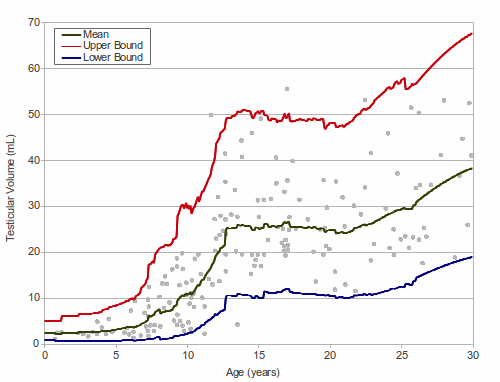
 Lost Souls Lost Souls
|
 Peds Atlas Peds Atlas
|
 Volumes Volumes
|
 Aortic Diameter - Adult Aortic Diameter - Adult
|
 Kidney Size - Peds Kidney Size - Peds
|
 Spleen Size - Peds Spleen Size - Peds
|
 Testicular Volume Testicular Volume
|
 Lung Nodule 2017 Lung Nodule 2017
|
 Contact Contact
|
Testicular Volume Percentile Calculator (ages < 30 years)
contributed by Michal Kulon, MD on 9/15/2015
For males aged 0 years 0 months 0 days:The average cube-root of testicular volume is 1.36, corresponding to volume of 2.51 ml
Standard deviation of cube-root of testicular volume is 0.18

Methods
- Normal range data based on Rundle AT, Sylvester PE. Measurement of Testicular Volume. It's application to assessment of maturation, and its use in diagnosis of hypogonadism. Arch Dis Child 37:514-517, 1962
- Ellipsoid approximation is not suitable for estimation of testicular volumes, and multiplier of 0.71 is advised.
- CAUTION: Authors report inclusion of 215 patients, but the graph presented in the above article contains only 175 data points (figure 1). The reason for this discrepancy is unknown, possibly due to overlapping of patients with identical ages and identical measured volumes, or possibly some patients older than 30 years did not appear on the graph.
- CAUTION: Measurements were performed using mechanical calipers. Correlation with ultrasound or other modalities has not been established.
- Raw data was not published. Derivation from the graph in Figure 1 was therefore necessary. This was done by software implementation of Hough Transform, with the expectation of finding filled circles.
- Q-Q plot of the volume data residuals reveals deviation from a Gaussian distribution. To correct this, power transform was applied, using power of 0.3333 (i.e. a cube-root of volume for each data point). Q-Q plot of the transformed data shows good agreement with Gaussian distribution. Shapiro-Wilk test for normality of the transformed data residuals does not reject the hypothesis that the data derives from a normal distribution (P=0.177).
- Regression was applied to the power-transformed data, and standard deviation of the residuals was computed.
- This calculator performs multiple quadratic regressions, each quadratic regression centered at the age of interest, spanning relatively short age range (30 data points). Exceptions are made for youngest and oldest age groups, where it not possible to center the regression.